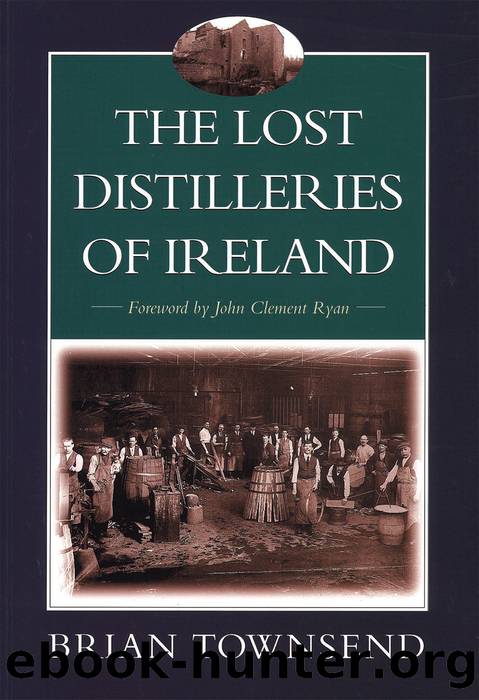The Lost Distilleries of Ireland by Brian Townsend

Author:Brian Townsend
Language: eng
Format: epub
ISBN: 9781906000097
Publisher: Neil Wilson Publishing
Published: 2015-01-15T00:00:00+00:00
Bow Street Distillery, c1880. This illustration is taken from Alfred Barnardâs Whisky Distilleries of The United Kingdom. The view is somewhat stylised and may be compared to the 1996 view of the Bow Street site which was taken prior to its partial demolition.
Bow Street Distillery, 1996
The distillery stood just outside the original gates of Dublin beside the Smithfield market, where cartloads of barley and other crops were daily available. Yet years before anyone else, Jameson had insisted that only the most suitable barley would make the finest whiskey. He scoured the countryside for the best strains and paid farmers well above market price to grow it, sometimes in advance â an unheard-of idea in those days. He built or acquired grain stores in Drogheda and other locations distant from Dublin to store the barley and other cereals ordered for Bow Street.
He was said to be obsessed with every detail of the product, from raw materials through production to final maturation. Process water was drawn from wells under the five-acre distillery site: an oak forest from Celtic times had stood there and was said to give the water special qualities. He dug hundreds of feet of cellars under adjacent streets so casks could mature in ideally cool, damp conditions. Later he built multi-storey warehouses and ensured rainwater was trapped in deep runnels at the top of the walls so the same cool dampness prevailed in those warehouses.
He also believed in long maturation and laid down his whiskey for longer than most other distillers. All of his ideas cost money or tied up large amounts of capital for years on end. Competitors sniffed and doomsayers foretold that he would go to the wall. But he didnât, and many of his ideas are still applied and emulated today. He was arguably the single main driving force behind the success of the Irish whiskey industry in the 19th century. Everything he did others copied â or were eventually obliged to copy.
In retrospect, one can say that he â or perhaps his heirs and successors â had two blind spots. For decades they declined to go into bottling, preferring to supply whiskey by the barrel or cask to trusted merchants who would sell it on or bottle it as Jamesonâs whiskey. Woe betide a bottler who adulterated Jamesonâs best with cheap grain whiskey and still sold it under their name. Not only did they blacklist him, they also invariably prosecuted.
Download
This site does not store any files on its server. We only index and link to content provided by other sites. Please contact the content providers to delete copyright contents if any and email us, we'll remove relevant links or contents immediately.
Zero to IPO: Over $1 Trillion of Actionable Advice from the World's Most Successful Entrepreneurs by Frederic Kerrest(4226)
Machine Learning at Scale with H2O by Gregory Keys | David Whiting(4094)
Never by Ken Follett(3758)
Harry Potter and the Goblet Of Fire by J.K. Rowling(3758)
Ogilvy on Advertising by David Ogilvy(3481)
Shadow of Night by Deborah Harkness(3277)
The Man Who Died Twice by Richard Osman(2977)
Book of Life by Deborah Harkness(2850)
0041152001443424520 .pdf by Unknown(2769)
Will by Will Smith(2766)
My Brilliant Friend by Elena Ferrante(2758)
How Proust Can Change Your Life by Alain De Botton(2726)
The Tipping Point by Malcolm Gladwell(2694)
Purple Hibiscus by Chimamanda Ngozi Adichie(2620)
How to Pay Zero Taxes, 2018 by Jeff A. Schnepper(2577)
Hooked: A Dark, Contemporary Romance (Never After Series) by Emily McIntire(2480)
Rationality by Steven Pinker(2271)
Borders by unknow(2209)
Can't Hurt Me: Master Your Mind and Defy the Odds - Clean Edition by David Goggins(2142)
